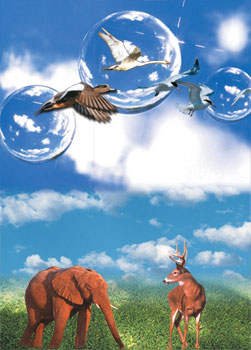 |
The preceding sections of this book have examined the complexity of animals' migratory behaviors and mechanisms. The very fact that such complex behaviors exist constitutes evidence that God has created these animals.
But how does Darwinist evolutionary theory—which claims that animals appeared as a result of natural effects and coincidences—explain migration? What claims do evolutionists make on the subject of migration?
This chapter offers a brief answer to this question and you will see that on the subject of migratory behavior and mechanisms, evolutionary theory comes to a dead end.
On the one hand, animal migration shows the superior knowledge of God in creation, but also exposes the invalidity of the claims of evolutionary theory. As we know, evolutionary theory tries to explain the root of animals' behavior to so-called evolutionary mechanisms—mutations brought about by coincidental effects and the unconscious process of natural selection. According to this theory, these unconscious evolutionary mechanisms can eventually explain every question on the origin, variety and behavior of animals. However, scientific developments have produced conclusions that totally contradict the evolutionists' expectations.
Findings in paleontology, biochemistry, anatomy and genetics have shown evolutionary theory to be based on false claims. The defeat of its claims by modern science is the subject of several of our books. (For detailed information, see Darwinism Refuted, The Evolution Deceit, and The Collapse of the Theory of Evolution in 20 Questions.) In this chapter, it will suffice to touch upon how the evolutionists cling to their theories with contrived elucidations in their attempts to explain various aspects of animal behavior.
First, evolutionary sources offer no satisfactory or tenable explanations for animals' migratory and navigational skills. This is surprising, as the evolutionists often make up false evidence when they cannot find support in fields such as paleontology or molecular biology. Animal migration does not lend itself to such fabrications, which is why evolutionists' efforts to explain migrating animals are based on no evidence and go no further than a few biased hypotheses. To evolutionists, it's a total enigma how animals reach their destinations without going astray, how they muster the energy to travel thousands of kilometers, how they develop strategies to cope with weather conditions, and how their memories are strong enough to let them remember the way back. The following is an admission that evolutionists are aware of the difficulties they have on this subject and the contradictions of their explanations:
| |
Snow geese migrate over very great distances, and are rarely sighted for part of the journey, since they fly at such high altitudes. |
There's a lot of controversy about how migration developed, and a lot of competing theories. It probably is a mixture of competition and climate and food availability. And probably partly just accident.56
On the flight of migrating birds, the Danish ornithologist Finn Salomonsen has this to say:
The ability of birds to find their way while flying is a mystery and a puzzle. Few other questions have over the years given rise to so many theories and speculations as this one.57
 |
Evolutionary theory is based on the results of coincidental effects. The very word "coincidence" suggests unconscious, random, unplanned and haphazard events. Yet in their explanations, evolutionists use the concept of coincidence as a system of conscious, rational intelligence and a source of knowledge. Evolutionary sources refer to coincidence as a power with foresight that can take preventative measures, create perfect designs, and make decisions for a specific purpose. When animals' circumstances change, coincidence is described as making the necessary adjustments and innovations. These claims surely give rise to certain questions:
How can random effects create a characteristic in an animal, of whose effects themselves have no knowledge? How can they program it into that animal's genetic code so it can be passed on to future generations? It is doubtless impossible for coincidence to identify a need and create appropriate solutions. And it is beyond the realms of probability for an animal to differentiate by trial and error whichever characteristic serves it best from those that do not.
In migration, many animals cover vast distances with nothing to show the way or any instrument to guide them. When weather conditions and climatic changes are taken into consideration, as well as the size of the animals, this phenomenon takes on new dimensions. Migration's remarkable aspect lies not just in the length of the distances covered. Some migratory birds return to their former winter habitat after spending several years in one region. Some of their journeys are made by individual, solitary birds and during the night. And whether the journey is to be 1,000 or 10,000 kilometers (620 or 6,200 miles), great physiological preparation is necessary. Some of the problems that migrators may encounter include high energy requirements, being carried off course by harsh weather conditions, finding food and defending against predators. How do birds manage to cover these distances in spite of all these difficulties? Moreover, some animals decide to migrate even when not forced to do so by such reasons as harsh weather or scarce food—but how do they know when to do so? And who guides them on their journey? How can random coincidences teach birds how to store the energy needed for long distance travel, navigate, and judge time? Darwinists pass over such questions with veiled explanations like the following:
The migratory habit has evolved independently among many kinds of birds. Different species travel in different directions, to different places, at different times, and for different reasons. Whatever the causes, migration would not have evolved unless the benefits exceeded the hazards.58
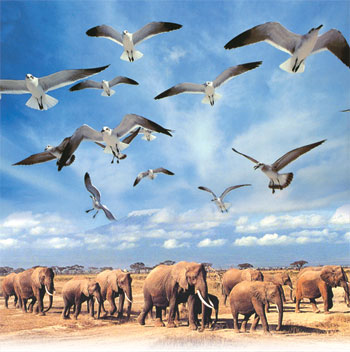 |
Those who consider no possibility besides evolution draw biased, limited conclusions in evolutionary terminology that doesn't clearly express the intended meaning. They clearly overlook the remarkable aspects of animals risking their lives in crossing vast oceans and deserts. Why do they feel the need to set off on such a dangerous journey? How would they know they will find a suitable habitat where they have never been before? Deviating from the journey by even one degree could bring creatures to the middle of an ocean or desert, so how do they manage to navigate so perfectly?
Migrating animals are also very exact in the timing of their journeys. What makes a flock of birds take off at the same moment, as though in agreement with one another? Who calculates the same period every year? What makes the intricate mechanism known as "the biological clock," claimed to regulate annual behavior, work so perfectly? Who lets them know when the time has come and initiates their pre-programmed movement?
Evolutionary ornithologists claim that birds' migration routes are shaped by weather conditions, subject to change with each new generation. However, none of these elucidations explains how birds can establish that there are suitable climatic conditions and a plentiful food supply on the other side of the world, and can judge the best routes as though reading a map. What's more, evolutionists are unable to answer how these migration routes are passed on to subsequent generations.
There is no question of coincidences defining time and having knowledge of navigation, and making these conscious concepts manifest in living creatures. All these questions indicate the presence of a Creator possessing infinite knowledge and intelligence. As a verse of the Qur'an makes known, all living creatures are under the control of God, "... there is no creature He does not hold by the forelock" (Surah Hud, 56).
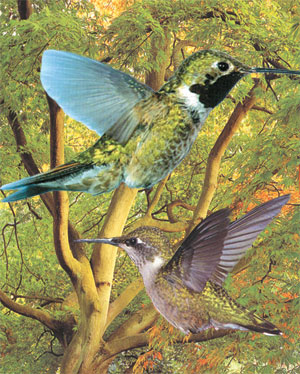 Hummingbirds beat their wings 20 to 80 times per second. That they do this without harm is an indication of their bodies' perfect structure. Even though hummingbirds flap their wings millions of times during migration, their muscles do not sustain the slightest damage. |
New-hatched chicks follow exactly the same migration routes used by previous generations, without the guidance of experienced birds. The hummingbird has a brain the size of a grain of corn and a body weighing 2 to 5 grams (0.07 to 0.1 ounces), yet it covers great distances perfectly. According to evolutionists, natural selection is why a living creature lives in harmony with its environment and migrates to a more beneficial region. But when evolutionary scientists claim that there is competition and struggle between living creatures in nature and that animals are still evolving by means of natural selection, they are making a great scientific blunder. Today, it is an accepted fact that natural selection has no evolutionary effect and therefore, falls far short of explaining the origin of living species.
According to natural selection, creatures whose physical characteristics make them best adapted to their environment have a better chance of surviving to breed. However, this advantage never results in the creature's evolution. For example, birds' tendency to migrate is no reason for large wingspan, as some evolutionists claim. Natural selection will never transform them into a different living species or provide them with any organ or characteristic that they didn't already possess. Natural selection can only encourage birds with large wings to fly greater distances, to where better living conditions prevail.
As a mechanism, natural selection was described before Darwin. For example, in a flock of birds threatened by freezing cold, those physically able to fly long distance will survive and over time, the rest will become fewer in number or die out. But Darwin gave natural selection a different meaning. By asserting that this mechanism created new species over the course of time, he suggested the possibility of migration creating different species. But today, even evolutionists acknowledge that natural selection has no power to make living creatures evolve.
Natural selection adds no new information to the gene pool of living creatures, and thus cannot provide them with new characteristics. Some evolutionists also claim that the characteristics that creatures acquire through natural selection are passed on to the next generation. Before Darwin, the French biologist Lamarck advanced the theory that living species evolve from one another. In his book, Zoological Philosophy, Lamarck asserted that creatures passed on changes they acquired in the course of their lives to future generations. In his famous example, he claimed that giraffes originally had much shorter necks, but with each subsequent generation, their efforts to reach tall trees made their necks grow longer.
 Lamarck's "transfer of acquired characteristics" was invalidated with the discovery of the laws of heredity. In the mid-20th century, the discovery of DNA proved that genetic information is encoded in the nucleus of cells of living creatures and could not be changed by "acquired characteristics." Even if an animal's neck stretched by a few centimeters over the course of its life, its young would still be born with necks of the standard dimensions. In short, scientific findings disproved Lamarck's theory as a false hypothesis.
Lamarck's "transfer of acquired characteristics" was invalidated with the discovery of the laws of heredity. In the mid-20th century, the discovery of DNA proved that genetic information is encoded in the nucleus of cells of living creatures and could not be changed by "acquired characteristics." Even if an animal's neck stretched by a few centimeters over the course of its life, its young would still be born with necks of the standard dimensions. In short, scientific findings disproved Lamarck's theory as a false hypothesis.
But to disguise the invalidity of this claim, some evolutionists put forward the concept of mutation. To date, however, no useful mutation for developing genetic information has been observed. Accordingly, living creatures' "irreducibly complex" structures invalidate the concept of "gradual accumulation of small changes," which is the essence of Darwinism. Richard Dawkins, one of Darwinism's staunch defenders, acknowledges the negative effects of mutation:
Notice that mutation pressure does not systematically drive in the direction of improvement. Nor do X rays. Quite the contrary: the great majority of mutations, however caused, are random with respect to quality, and that means they are usually bad..."59
Also, random changes in DNA do little to explain the migration phenomenon in animals. For example, how can a bird's flying for six weeks in a southeasterly direction, then four weeks in a northeasterly direction, be programmed gradually in its DNA's amino acid chain? Or how can a gene tell a fish when to migrate and where in the ocean it should go? No rational, intelligent person could agree that unconscious molecules can direct an animal so precisely as to when it should act and what it should do. But evolutionary biologists claim that selective genetics lets animals "bequeath" useful forms of behavior to future generations. Even though he is an evolutionist, Gordon R. Taylor criticizes this claim in his book dealing with subjects that Darwinism cannot explain:
But the plain fact is that the genetic mechanism shows not the slightest sign of being able to convey specific behaviour patterns. What it does is manufacture proteins. By producing more of certain hormones it could affect behaviour in an overall way – making the animal more aggressive, more passive or perhaps even more maternal. But there is not the faintest indication that it can hand on a behavioural programme of a specific kind, such as the sequence of actions involved in nest building. If in fact behaviour is heritable, what are the units of behaviour which are passed on – for presumably there are units? No one has suggested an answer. 60
In saying, "Why a particular type of organism displays the behavior components it does is a result of evolution,"61 Darwinists lead the evolutionary scenario to an even greater impasse. According to them, all seemingly conscious behavior in animals is to be explained as instincts directed by coincidences. However much you try to explain this using a different concept such as "instinct," coincidence essentially expresses an unconscious, random intervention. From the evolutionists' perspective, the idea of an instinct making conscious precautions to ensure animals' continued existence constitutes a serious contradiction. As already pointed out, one of the first to confess the weakness of claims concerning instinct was Charles Darwin himself:
so wonderful an instinct as that of the hive-bee making its cells will probably have occurred to many readers, as a difficulty sufficient to overthrow my whole theory. 62
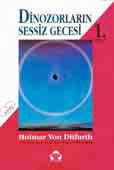 Darwin was also aware that evolution could not explain the conscious behaviors he observed in nature. Intelligent logic shows the truth of this. But a number of evolutionists still try to explain Darwin's long-since-discredited theory with meaningless words. In spite of being an evolutionist, the famous German biologist Hoimar Von Ditfurth admits that animal behavior is a matter of rational intelligence and consciousness:
Darwin was also aware that evolution could not explain the conscious behaviors he observed in nature. Intelligent logic shows the truth of this. But a number of evolutionists still try to explain Darwin's long-since-discredited theory with meaningless words. In spite of being an evolutionist, the famous German biologist Hoimar Von Ditfurth admits that animal behavior is a matter of rational intelligence and consciousness:
... when the behavior we have been describing from the outset is considered, one is struck by specific criteria regarding the way these are "regulated by intelligence" in a very special sense. If aiming towards a particular aim and objective, predicting future events, and calculating the likely behavior and reactions of living species outside oneself are not signs of intelligence, then what are they?63
But then he resorts to demagogic methods so as not to acknowledge that the remarkable indications of intelligence are evidence of creation:
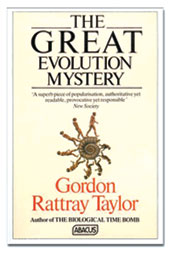
In the past, naturalists did not content themselves with believing in a miracle when they encountered such phenomena, in other words they could not prevent themselves from thinking that God had equipped His creations with the necessary information for their protection. Yet such an explanation means suicide for the naturalist, or rather the denial of scientific truth and its existence. On the other hand, the way that modern science seeks to account for such phenomena in terms of "instinct" actually has very little meaning. That is because, contrary to what most of us think, regarding what has taken place as the work of instinct […] and this takes us very little further forward and prevents us finding an answer to the fundamental question...64
As the evolutionists are also aware, the word "instinct" has no elucidative meaning, but has become a refuge for those who do not acknowledge the inspiration of God. Evolutionary scientists use "instinct" to define certain innate aspects of animal behavior. Always left unanswered, however, are the questions of how animals acquire these instincts, and how instinctive behavior first emerged and was passed on from generation to generation. In The Great Evolution Mystery, evolutionary geneticist Gordon R. Taylor makes the following confession on this impasse:
 |
When we ask ourselves how any instinctive pattern of behaviour arose in the first place and became hereditarily fixed, we are given no answer.65
Certain evolutionists who do not admit the truth like Taylor try to get around these questions with veiled answers that are really meaningless. One of the greatest mistakes is the claim that over time, instincts have been shaped into their present form and passed on from generation to generation. This is the same logic used by Lamarck, proven to be a myth more than a century ago. In fact, even evolutionary scientists acknowledge the implausibility of instinct and impulses being passed on from generation to generation.
Taylor evaluates the claim that behavior can be inherited as "lamentable":
Biologists assume freely that such inheritance of specific behaviour patterns is possible, and indeed that it regularly occurs. Thus Dobzhansky roundly asserts: "All bodily structures and functions, without exception, are products of heredity realized in some sequence of environments. So are all forms of behaviour, without exception." This simply isn't true and it is lamentable that a man of Dobzhansky's standing should dogmatically assert it..66
These creatures were not able to invent the extraordinary characteristics they possess, but were born with these characteristics. It is our Lord God, Whose intelligence and knowledge is supreme, Who creates them in a fashion that enables them to display these characteristics.
 Basing the origin of animals on their so-called struggle for survival, evolutionary theory supposes that new species arise from the gradual addition of small coincidental advantages gained in the course of this struggle over time. A small bird only a few weeks old sets off on a journey thousands of kilometers long, but its success is due to its having the necessary structure and perfect mechanisms. Accordingly, it's not possible for the necessary organs and behavior to develop in stages, because for any animal lacking the necessary equipment and skills, the chances of survival would be very slim, as an evolutionary source mentions:
Basing the origin of animals on their so-called struggle for survival, evolutionary theory supposes that new species arise from the gradual addition of small coincidental advantages gained in the course of this struggle over time. A small bird only a few weeks old sets off on a journey thousands of kilometers long, but its success is due to its having the necessary structure and perfect mechanisms. Accordingly, it's not possible for the necessary organs and behavior to develop in stages, because for any animal lacking the necessary equipment and skills, the chances of survival would be very slim, as an evolutionary source mentions:
The risk of mortality during migration is great; the evolution of migration in the face of this risk is one of the aspects of this behavior that still requires explanation.67
But this impasse does not deter evolutionists from making fantastic speculations about migration. Their most publicized scenario is based on the retreat of icebergs, as is related in an evolutionary source:
One widely held idea has been that glaciation explains the evolution of migration. Some believe that advancing glaciers pushed temperate zone birds into the tropics. When the glaciers retreated, the descendants of these birds returned to their ancestral homes. Others think that glaciers prevented tropical birds from spreading into temperate regions. When the glaciers retreated, these birds were able to spread into areas that had been ice-covered. Their descendants returned, however, to their ancestral homes in the tropics.68
There are serious contradictions in the explanations linking migratory behavior in animals to hereditary characteristics shaped by coincidental effects. Information encoded in an animal's DNA cannot create compatibility with environmental factors or be influenced by any aspect of an animal's behavior. As already explained, this unscientific logic emerged in an era before any knowledge of genetics. For example, even if migration in birds began in ancient times when moved to a different place as the icebergs retreated, that does not support the evolutionist claims of corresponding changes in genetic information. Wherever all the members of one species move, or however often they travel, it has no effect whatsoever on their DNA. In short, migratory behavior is not added into the genes of living creatures.
If migratory behavior is not exactly correct, it is disadvantageous to the species and can even be fatal. As evolutionists have also stated, during migration the risk of mortality is great and no living species has time to wait for random mutations to let it acquire accurate migratory behavior. It is illogical to accept that migratory knowledge, passed on genetically and which enables a bird to find a place it has never been before, has emerged as a result of mutations known for harmful effects.
The "planning" in migratory behavior is so complex that refusing to see it as the product of creation can be explained only with Darwinist dogmatism. For example, consider the preparations that start taking place prior to migration: Birds go into an accelerated feeding to store energy for their upcoming journey. Some birds double their body weight in this period of excessive eating known as "hyperphagia," which is part of the genetically controlled migration process. Interestingly, this behavior starts two to three weeks before migration, just before the food supply diminishes, which prevents the birds from experiencing lack of energy before their long journey. From the bird's point of view, this is an extremely effective precautionary mechanism. Evolutionists assert that all the mechanisms in this physiological adaptation are linked to random mutations accumulated in the bird's DNA, but they can show no evidence.
Another physiological mechanism related to migration that evolutionists cannot explain is the marked changes in birds' hormone levels. The neuroendocrinal system, responsible for nervous stimulation and inner hormone secretion, triggers diurnal changes affecting the pituitary gland and the pineal, the gland in brain for secretion of the hormone melatonin related to sleep. The joint actions of the hormones corticosterone and prolactin are thought to stimulate nocturnal restlessness (zugunruhe), which increases during migratory times of the year.69 The molecular structure of hormones playing a role in this complex endocrinal process is so finely calibrated that it's not possible for even one such hormone to appear by chance. Nor is there any scientific evidence of this. (For detailed information, see Harun Yahya, The Miracle of Hormones, Goodword Books, September, 2003.)
Another feature that cannot be explained by mutations is that some migrating birds fly at high altitudes. For example, the bar-headed goose, Anser indica, is known to fly over the Himalayas at an altitude of 9,000 meters (29,500 feet). At such altitudes, the atmosphere is lacking in oxygen, and the oxygen-carrying capacity in the birds' blood is increased by a high concentration of red blood cells. Unlike non-migratory birds, the hemoglobin in some migrating birds is found in two separate forms, differing in their oxygen carrying and releasing capacities. This special creation lets the bird adapt rapidly to varying levels of oxygen availability as it moves between different altitudes.70 This superior ability could be an advantage only if the bird's body was ideally created. Accordingly, the complex structure of living species, and the remarkably skillful behavior, are too perfect to consider the possibility of coincidence.
Scientists studying and conducting experiments on migration have concluded that the mechanisms that make migration possible are genetically transferred. Two different such experiments are quite illuminating:
1) In one experiment, the eggs of the herring gull, a bird that does not usually migrate, were exchanged with the eggs of the migratory Lesser black-backed gull. Consequently, 900 hatchlings emerged in the nests of the wrong family. Even though their "adopted" families did not migrate, the Lesser black-backed gull hatchlings did!
2) Professor Peter Berthold, who has researched bird migration for some 20 years, is president of the Max Planck Research Center for Ornithology in Vogelwarte Radolfzell, Germany. Berthold and his team confined thousands of migratory birds in one place and studied their movements. The results were as follows:
a) The birds' migratory behavior showed an inner and annual rhythm. (These rhythms that organize animal behaviors which require physiological arrangements such as hibernation are based on a genetic "biological clock.") Although the birds were kept in a constant environment with fixed cycles of light and darkness, they showed a number of changes: weight gain, renewal of feathers, and nocturnal restlessness at the appropriate times of the year—spring and autumn. Even though they had no natural environment to remind them, some program in their bodies prepared them for migration. The scientists concluded that this behavior was pre-programmed.
b) 97% of the captive birds began their activity at the same time as birds in nature set off.
c) Different bird species subjected to the experiment showed different levels of activity, appropriate to their own migratory behavior. For example, birds migrating over longer distances showed activity over longer periods.
d) Crossbreeding trials showed that the quality of migratory activity is population-specific and pre-programmed, or genetic.
 Furthermore, birds in the experiment changed direction from southwest to south at the time when they would be expected do so on their normal migration crossing the Mediterranean near Gibraltar. Accordingly, birds have a mechanism that tells them not only how long the migratory activity will last, but also at what point in the migratory journey they must change direction.
Furthermore, birds in the experiment changed direction from southwest to south at the time when they would be expected do so on their normal migration crossing the Mediterranean near Gibraltar. Accordingly, birds have a mechanism that tells them not only how long the migratory activity will last, but also at what point in the migratory journey they must change direction.
Today, scientists agree that these exceptional skills are pre-programmed in birds, as is related in an article in Science magazine:
There is good evidence that young birds are equipped with endogenous migratory programs, which tell them roughly how many days and/or nights that they must fly, and in what direction.71
Just as other researches revealed that penguins used the Sun to navigate, scientists also discovered that penguins have a biological clock that is adjusted in accordance with their original location. So the Cape Crozier penguin migrated according to Cape Crozier time. In addition, they discovered that young penguins were just as adept at navigating as the adults, meaning that penguin chicks are born with this knowledge.72
Although the mechanisms that play a role in migration have not been definitively brought to light, it is widely believed that they emerge at birth as pre-programmed behavior. But how can complex behavior be transferred genetically? Is there some program in the genes to direct behavior?
Even if migratory behavior in animals is transferred genetically, how is this heredity achieved? Animals display exceptionally complex detailed migratory behavior. On flights covering thousands of kilometers, do strings of amino acid in the genes determine the preparations beforehand and the directional and navigational skills during the migration?
If the answer is yes, and if a genetic program determines migration, this, too, constitutes a great impasse for evolutionary theory since the genetic encoding of such complex information cannot be explained by evolutionary mechanisms. As is the case with the origin of new organs and biological structures, this complex and detailed information cannot be explained by natural selection. Believing that information defining migration is produced by random mutations is like believing that a road map can arise from ink accidentally spilt on a piece of paper.
No one of common sense could believe in such an impossibility. The logical explanation is not the work of chance, but of an almighty intellect. In other words, what is logical is to accept that our Creator gives birds their knowledge of migration.
And the information coded in the cells of migrating creatures has not come into existence over time by the accretion of random atoms and molecules as a result of unconscious coincidences. This extensive knowledge is the work of the eternal power of God, the Creator of all.
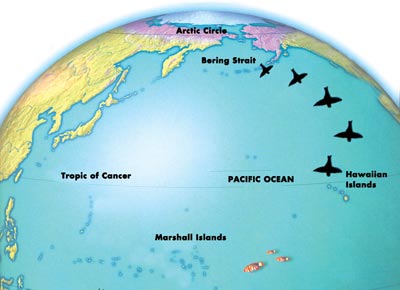 |
|
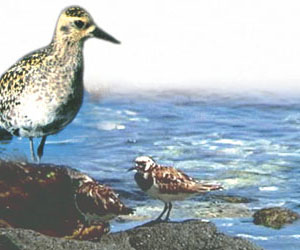 |
To spend the winter, plovers migrate from Alaska to Hawaii. They must fly non-stop over the ocean, because there are no islands on their route and they are not a species that can swim. During their 4,000-kilometer (2,400 mile) journey, which takes 88 hours, their wings beat an incredible 250,000 times. At the start of their journey, they weigh 200 grams (7 ounces), of which 70 grams (2 ounces) consist of fat to be burned as fuel. These birds consume 0.6% of their body weight every hour. By this calculation, in 72 hours—81% of the necessary flying time—they need to consume 70 grams (2 ounces) of their fat, virtually all their fuel. This should make the birds fall into the ocean some 800 kilometers (500 miles) before their destination—but that never happens.
Werner Gitt, professor and director at the German Federal Institute of Physics and Technology, gives the following explanation of how these birds manage to complete their 88-hour flight with only 70 grams of fat:
We regard the Creator's work with amazement. He employs the fundamental theorem which states that "energy input is optimized through information." In the case of the plover this means that the bird has been given some important additional information, namely: "Do not fly alone, but fly in a V formation! In the V formKuation you will save 23 % of your energy and will then safely reach your destination"… After 88 hours the normal residual amount of fat is 6.8 g, which has not been carried along unnecessarily, but is a reserve to be used when headwinds are encountered. The extremely low specific rate of fuel consumption, p = 0.6 % of its weight per hour, is all the more amazing when we compare it with that of manmade aircraft which is orders of magnitude greater (for a helicopter p = 4 to 5 %; and p = 12 % for a jet plane).73
As the example of this bird shows, there is no room for coincidences in migratory flight. On the contrary, there are fine mathematical calculations that we have not included here. This efficient way of flying, which even man has not yet succeeded in duplicating, raises a number of questions:
The clever planning and techniques of these creatures devoid of conscious intelligence, with no decision-making or judgmental ability, and with bodies perfectly suited to this purpose, can only be explained by one truth. These creatures act under the inspiration given them from the first moment of their creation. They continue their lives under the order and control of our Lord, the Creator of all things.
 | |
In his documentary entitled Incredible Creatures That Defy Evolution Dr. Jobe Martin uses the plover as an example to invalidate evolutionary theory:
How does evolution explain how a migratory animal gets from where he is in the summer to where he is in the winter? Usually the explanation is: "You have this certain kind of bird and he grows in Texas. And then one winter Texas has a cold winter, so he decides 'You know something? I'm heading for Mexico.' So he flies a few hundred miles south, 'Oh, it's really nice down here.' Then he comes back to Texas in the summer. But it's an especially hot summer. So he decides 'You know, I think I'm going to go to Kansas.' So he flies north, looking for a little cooler weather. And then each year, he may go a little further south, a little further north until they get all the way up to the Arctic and all the way down to South America." Well, this little bird breaks that rule. First of all, it's a very small bird, about the size of a dove. And it's not a swimmer. And it lives up in the Arctic, in Alaska actually. They leave their young and then fly to Hawaii for the winter. Now, when it leaves Alaska, it has an 88-hour flight, nonstop because there is no land in between. Three days and four nights, nonstop. How does it do that? Well, these little birds begin to eat a lot, and they gain about 70 grams of burnable energy. Here is the problem: We've got an 88-hour flight, and they burn 1 gram per hour. That only gives them 70 hours worth of fuel. So they're going to drop into the ocean as non-swimmers, a few hours short of Hawaii. Well then, how do they get there? Well, because God made them so they fly in formation and they alternate leaders and so they break the air waves there so it makes it easy like geese fly in formation. And that cuts the energy it takes to fly... The evolutionary explanation doesn't fit because there's no way they could go a little bit each year. A little bit further south; they're fish prey. So they can't do it. So the evolutionary explanation doesn't work on that.74
It is not possible for this little bird to establish by trial and error what method it should use and how much fat it should burn in order to be able to migrate. Failure on any flight would mean death for the bird, and no question of it passing on its experience to future generations. It is ridiculous to assert that through some unconscious mechanism such as natural selection, a bird has learned that it is not possible to fly alone or with 50 grams (1.7 ounces) of fat. It is also beyond the realms of probability that genetic coding of finely calculated flying techniques is based on destructive influences like mutations.